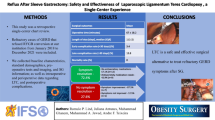Abstract
Rectal prolapse is a debilitating condition predominant in the elderly female population. Etiological factors include age, multiparity, and anorexia. The diagnosis is clinical but a full assessment of pelvic floor function and the exclusion of organic disease are essential prior to operative intervention. As concomitant urogynecological disorders are present in a third of patients, discussion in a pelvic floor multidisciplinary team forum is mandated. Surgical correction can be performed using a perineal or an abdominal approach. The heterogeneity of trial design in the current literature makes direct comparison of the techniques difficult. Perineal approaches are generally preferred in high-risk, elderly patients as they can often be performed under regional anesthesia. The evidence surrounding the technical aspects of abdominal rectopexy, such as the need to perform a colectomy or the decision to preserve/divide the lateral ligaments, is examined in this review. In abdominal surgery, the use of minimally invasive laparoscopic techniques and enhanced recovery protocols are recommended.


Similar content being viewed by others
References
Birnbaum EH, S. L. (1996) Pudendal nerve terminal motor latency influences surgical outcome in treatment of rectal prolapse. Dis Colon Rectum 39(11):1215–1221
Bordeianou L, H. C. (2014) Rectal prolapse: an overview of clinical features, diagnosis, and patient-specific management strategies. J Gastrointest Surg 18(5):1059–1069
Gurland B, M. a. (2008) Transrectal ultrasound, manometry, and pudendal nerve terminal latency studies in the evaluation of sphincter injuries. Clin Colon Rectal Surg 21(3):157–166
Christiansen J, Z. B. (1992) Internal rectal intussusception: results of surgical repair. Dis Colon Rectum 35:1026–1029
Constantinos Sialakas MT (1999) Rectal prolapse in pediatrics. Clin Pediatr 38(2):63–72
Consten EC, v. I. (2015) Long-term outcome after laparoscopic ventral mesh rectopexy: an observational study of 919 consecutive patients. Ann Surg 262(5):742–747
Cunin D, S. L. (2013) No surgery for full-thickness rectal prolapse: what happens with continence? World J Surg 37(6):1297–1302
Dariane C, M. D. (2016) Concepts of the rectovaginal septum: implications for function and surgery. Int Urogynecol J 27(6):839–848
Altomare DF, Pucciani F (eds) (2008) Rectal prolapse: diagnosis and clinical management. Springer-Verlag Mailand
Elagili F, G. B. (2015) Comparing perineal repairs for rectal prolapse: Delorme versus Altemeier. Tech Coloproctol 19(9):521–525
Emile SH, Y. M. (2016) Effect of age, patient’s sex, and type of trauma on the correlation between size of sphincter defect and anal pressures in posttraumatic fecal incontinence. Surgery 160(5):1318–1325
Weiss EG, M. a. (2008) Functional disorders: rectoanal intussusception. Clin Colon Rectal Surg 21(2):122–128
Felt-Bersma RJ, T. E. (2008) Rectal prolapse, rectal intussusception, rectocele, solitary rectal ulcer syndrome, and enterocele. Gastroenterol Clin N Am 37(3):645–668
Foppa C, M. L. (2014) Ten-year follow up after laparoscopic suture rectopexy for full-thickness rectal prolapse. Color Dis 16(10):809–814
Formijne Jonkers HA, D. W. (2013) Evaluation and surgical treatment of rectal prolapse: an international survey. Color Dis 15(1):115–119
Glasgow SC, B. E. (2006) Preoperative anal manometry predicts continence after perineal proctectomy for rectal prolapse. Dis Colon Rectum 49(7):1052–1058
Jie-Hyun Kim MP (2010) How to interpret conventional anorectal manometry. J Neurogastroenterol Motil 16(4):437–439
John Nicholls RR (1997) Surgery of the colon & rectum. Churchill Livingstone, New York, Edinburgh, London, Madrid, Melbourne, San Francisco, Tokyo
Karas JR, U. S., & Group, R. P (2011) No rectopexy versus rectopexy following rectal mobilization for full-thickness rectal prolapse: a randomized controlled trial. Dis Colon Rectum 54(1):29–34
Kerry Hammond MD (2007) Rectal prolapse: a 10-year experience. Ochsner J 7(1):24–32
Kim AY (2011) How to interpret a functional or motility test - defecography. J Neurogastroenterol Motil 17(4):416–420
Kimmins MH, E. B. (2001) The Altemeier repair: outpatient treatment of rectal prolapse. Dis Colon Rectum 44(4):565–570
Mortele KJ, Fairhurst J (2007) Dynamic MR defecography of the posterior compartment. Eur J Radiol 61(3):462–472
Lieberth M, K. L. (2009) The Delorme repair for full-thickness rectal prolapse: a retrospective review. Am J Surg 197(3):418–423
Kairaluoma MV, I. H. (2005) Epidemiologic aspects of complete rectal prolapse. Scand J Surg 94:207–210
Madiba TE, B. M. (2005) Surgical management of rectal prolapse. Arch Surg 140(1):63–73
Madoff RD, M. A. (1999) One hundred years of rectal prolapse surgery. Dis Colon Rectum 42(4):441–450
Marceau C, P. Y. (2005) Complete rectal prolapse in young patients: psychiatric disease a risk factor of poor outcome. Color Dis 7(4):360–365
Watkins BP, L. J. (2003) Long-term follow-up of the modified Delorme procedure for rectal prolapse. Arch Surg 138(5):498–502
Senapati A, G. R., & Group, P. C (2013) PROSPER: a randomised comparison of surgical treatments for rectal prolapse. Color Dis 15(7):858–868
Mellgren A, B. S. (1994) Defecography. Results of investigations in 2816 patients. Dis Colon Rectum 37(11):1133–1141
Purkayastha S, Tekkis P (2005) A comparison of open vs. laparoscopic abdominal rectopexy for full-thickness rectal prolapse: a meta-analysis. Dis Colon Rectum 48(10):1930–1940
Satish SC, Rao MP (2015) ANMS-ESNM position paper and consensus guidelines on biofeedback therapy for anorectal disorders. Neurogastroenterol Motil 27(5):594–609
Goldstein SD, M. a. (2011) Rectal prolapse. Clin Colon Rectal Surg 24(1):39–45
Shin EJ (2011) Surgical treatment of rectal prolapse. J Korean Soc Coloproctology 27(1):5–12
Skandalakis JE (2004) Skandalakis’ surgical anatomy. Paschalidis Medical Publication Ltd., Stockholm
Sokol AS (2008). Clinical anatomy of the vulva, vagina, lower pelvis, and perineum. Retrieved from The global library of women’s medicine: https://www.glowm.com/section_view/heading/Clinical%20Anatomy%20of%20the%20Vulva,%20Vagina,%20Lower%20Pelvis,%20and%20Perineum/item/445.
Wexner SD, J. W. (2011) Colon and rectal surgery: abdominal operations. LWW, Philadelphia
Wexner SD, Fleshman JW (eds) (2011) Colon and rectal surgery: anorectal operations. LWW, Philadelphia
Sun WM, R. S. (2001) Manometric assessment of anorectal function. Gastroenterol Clin N Am 30(1):15–32
Author information
Authors and Affiliations
Corresponding author
Additional information
Publisher’s Note
Springer Nature remains neutral with regard to jurisdictional claims in published maps and institutional affiliations.
Rights and permissions
About this article
Cite this article
Soare, C., Lasithiotakis, K., Dearden, H. et al. The Surgical Management of Rectal Prolapse. Indian J Surg 83 (Suppl 3), 694–700 (2021). https://doi.org/10.1007/s12262-019-02058-0
Published:
Issue Date:
DOI: https://doi.org/10.1007/s12262-019-02058-0




